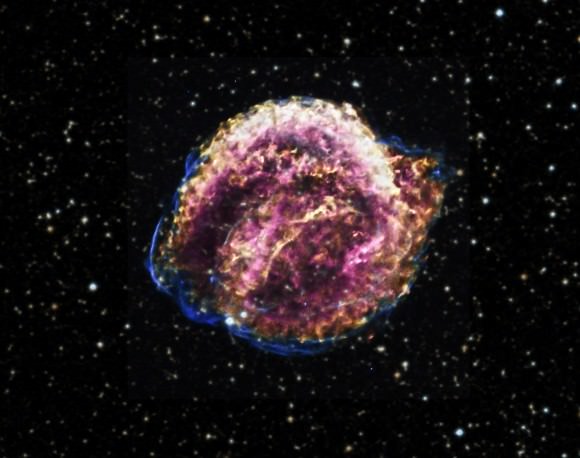Science
Related: About this forumThe Unusually Colossal Kepler Supernova

A composite image of Chandra X-ray data shows a rainbow of reds, yellows, green, blue and purple, from lower to higher energies. Optical data from the Digitized Sky Survey, shown in pale yellow and blue, offer a starry background for the image. Optical: DSS
An arc of hot gas that spewed from the Kepler Supernova offers tantalizing clues that the cataclysmic stellar explosion of 1604 was not only more powerful than previously thought but also farther away according to a recent study using Chandra X-ray Observatory data published in the September 1, 2012 edition of The Astrophysical Journal.
A new star appeared in the autumn skies of 1604. Although it was described by other astronomers, it was famous astronomer Johannes Kepler who thoroughly detailed the the second supernova sighting in a generation. The star shined more brilliant than Jupiter and remained visible – even during the day – over several weeks.
Look for Kepler’s Supernova at the foot of the constellation Ophiuchus, the Serpent Bearer, in visible light and you won’t see much. But the hot gas and dust glow brightly in the X-ray images from Chandra. Astronomers have long puzzled over Kepler’s Supernova. Astronomers now know the explosion that created the remnant was a Type Ia supernova. Supernovae of this class occur when a white dwarf, the white-hot dead core of a once Sun-like star, gains mass by either merging with another white dwarf or drawing gas onto its surface from a larger companion star until temperatures soar and thermonuclear processes spiral out of control resulting in a detonation that destroys the star.
Read more: http://www.universetoday.com/97314/the-unusually-colossal-kepler-supernova/
htuttle
(23,738 posts)I find image that beautiful, but it also sends a chill down my spine.
orpupilofnature57
(15,472 posts)longship
(40,416 posts)It is a planetary nebula, the putative exhalations of a star's outer layers as it evolves from red giant to white dwarf stage as it ages. The central star in M57 is a white dwarf.
Planetary nebula are much more plentiful than supernovae, which occur maybe once per galaxy per century (or so).
The brightest supernova from Earth's perspective in recorded history may have been Tycho's Star, 1572, recorded by Tycho Brahe (but likely discovered by another, W. Schuler). Interestingly, Tycho was Kepler's mentor. So these two men are related in that, within 35 years they both recorded the data on histories two brightest supernovae.
BTW, Tycho Brahe was a bit of a loony guy. He had an elk, a dwarf, and a gold and silver nose, having lost his in a sword duel. Alas, the elk lost its life when it -- yes, the elk -- got drunk on beer and fell down the stairs. Nobody records whether the elk said, "Watch this!" just before. History is a bit quiet about his... ahem... dwarf. His nose, however, is legend.
I am not making this up, you know.
Kepler inherited all Tycho's observational data, and with his own additions, solved the laws of planetary motion bearing his name. These, in turn, enabled Isaac Newton, upon seeing an apple fall, to solve the first theory of gravity which enabled Neil Armstrong to land on the moon centuries later.
"Standing on the shoulders of giants"
Indeed, especially one with a drunken elk. Poor thing.
orpupilofnature57
(15,472 posts)for the info and cool story about Brahe and Kepler .
muriel_volestrangler
(101,271 posts)on the antlers of drunken elks". Such is the wisdom of science ...
 &imgrefurl=
&imgrefurl=